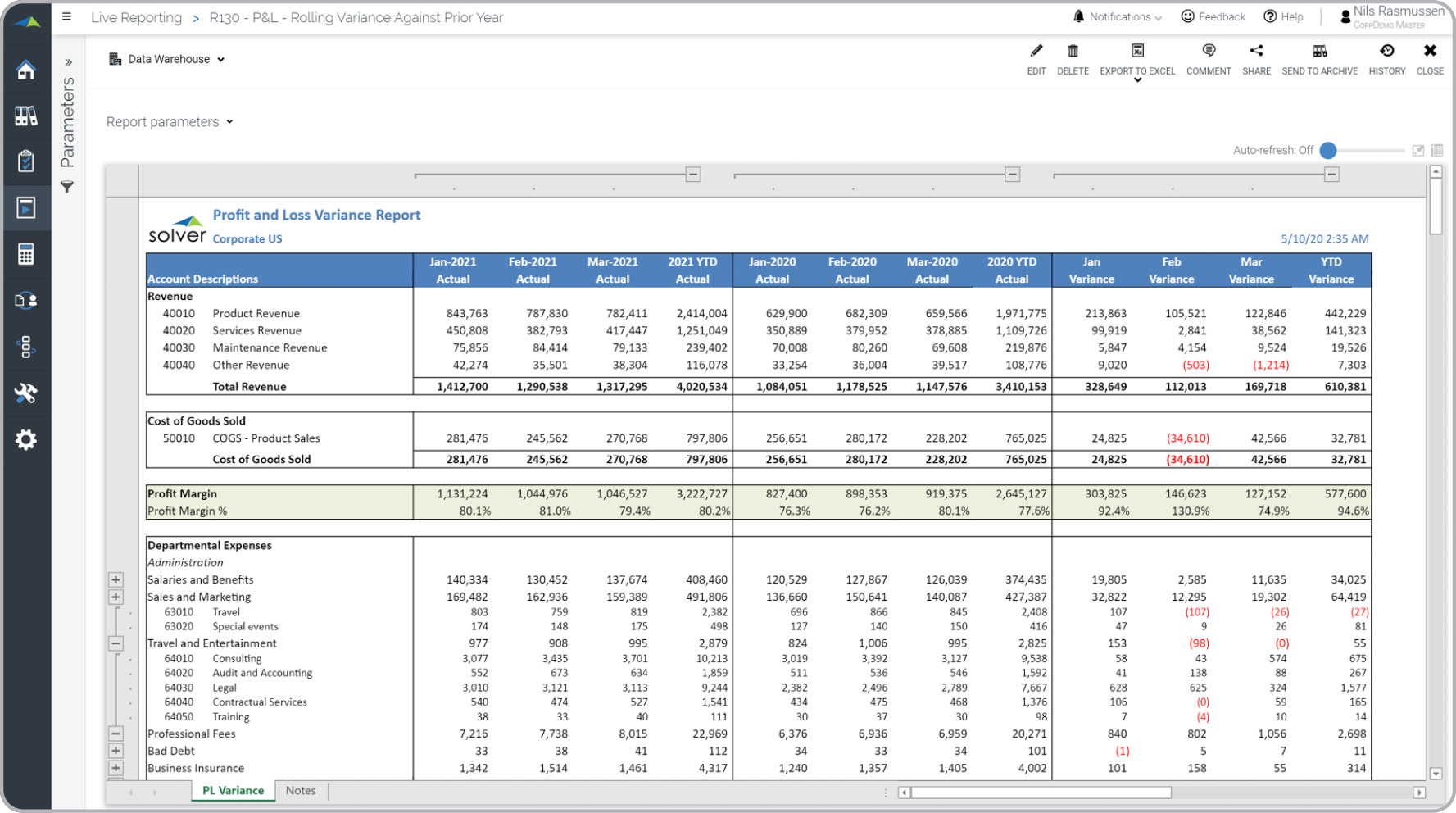Trended Profit & Loss Report for Current versus Last Year
What is
a
Trended Profit & Loss Report for Current versus Last Year
? Trended, current-versus-last-year financial statements are considered comparative reports and are used by CFOs and financial managers to discover significant trends and anomalies. Some functionality in this type of report will dynamically display all periods up to the current month for this year, as well as, for last year. It also provides year-over-year variances for each month. Additionally, each year can be expanded and collapsed for easier readability of the report. You will find an example of this type of report below.
Purpose of
Comparative Multi-Year Profit & Loss Reports Companies and organizations use Comparative Multi-Year Profit & Loss Reports to make it easy to find trends and anomalies. When used as part of good business practices in a Finance and Accounting Department, a company can improve its ability to detect financial issues or opportunities, as well as, mitigate the risk that managers limit their analysis to monthly, year-to-date and budget variances.
Comparative Multi-Year Profit & Loss Report
Example Here is an example of a trended Profit & Loss Report that displays individual months for current and last year with variances. [caption id="" align="alignnone" width="1777"]
 Trended Profit & Loss Report Example for Current versus Last Year[/caption] You can find hundreds of additional examples
here.
Who Uses This Type of
Report
? The typical users of this type of report are: Executives and Financial Managers.
Other
Report
s Often Used in Conjunction with
Comparative Multi-Year Profit & Loss Reports Progressive Finance and Accounting Departments sometimes use several different Comparative Multi-Year Profit & Loss Reports, along with trended balance sheets, cash flow statements and other management and control tools.
Where Does the Data for Analysis Originate From? The Actual (historical transactions) data typically comes from enterprise resource planning (ERP) systems like: Microsoft Dynamics 365 (D365) Finance, Microsoft Dynamics 365 Business Central (D365 BC), Microsoft Dynamics AX, Microsoft Dynamics NAV, Microsoft Dynamics GP, Microsoft Dynamics SL, Sage Intacct, Sage 100, Sage 300, Sage 500, Sage X3, SAP Business One, SAP ByDesign, Acumatica, Netsuite and others. In analyses where budgets or forecasts are used, the planning data most often originates from in-house Excel spreadsheet models or from professional corporate performance management (CPM/EPM) solutions.
What Tools are Typically used for Reporting, Planning and Dashboards? Examples of business software used with the data and ERPs mentioned above are:
Trended Profit & Loss Report Example for Current versus Last Year[/caption] You can find hundreds of additional examples
here.
Who Uses This Type of
Report
? The typical users of this type of report are: Executives and Financial Managers.
Other
Report
s Often Used in Conjunction with
Comparative Multi-Year Profit & Loss Reports Progressive Finance and Accounting Departments sometimes use several different Comparative Multi-Year Profit & Loss Reports, along with trended balance sheets, cash flow statements and other management and control tools.
Where Does the Data for Analysis Originate From? The Actual (historical transactions) data typically comes from enterprise resource planning (ERP) systems like: Microsoft Dynamics 365 (D365) Finance, Microsoft Dynamics 365 Business Central (D365 BC), Microsoft Dynamics AX, Microsoft Dynamics NAV, Microsoft Dynamics GP, Microsoft Dynamics SL, Sage Intacct, Sage 100, Sage 300, Sage 500, Sage X3, SAP Business One, SAP ByDesign, Acumatica, Netsuite and others. In analyses where budgets or forecasts are used, the planning data most often originates from in-house Excel spreadsheet models or from professional corporate performance management (CPM/EPM) solutions.
What Tools are Typically used for Reporting, Planning and Dashboards? Examples of business software used with the data and ERPs mentioned above are:
- Native ERP report writers and query tools
- Spreadsheets (for example Microsoft Excel)
- Corporate Performance Management (CPM) tools (for example Solver)
- Dashboards (for example Microsoft Power BI and Tableau)
Corporate Performance Management (CPM) Cloud Solutions and More Examples
August 20, 2020
TAGS:
Reporting,
Solver,
report writer,
Microsoft,
consolidation,
template,
practice,
Acumatica,
Netsuite,
Finance,
GP,
profit & loss,
Business Central,
excel,
ax,
income statement,
forecast,
Budget,
forecasting,
budgeting,
Cloud,
Software,
Tableau,
SAP,
example,
best,
Sage,
BC,
P&L,
D365,
NAV,
Intacct,
Variance,
CPM,
report,
SL,
Management,
dynamics,
Power BI,
months

